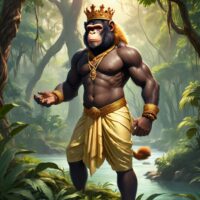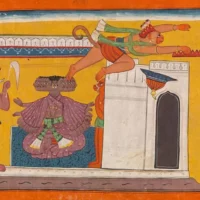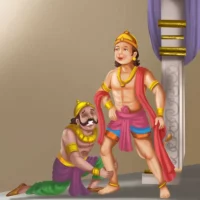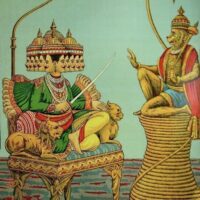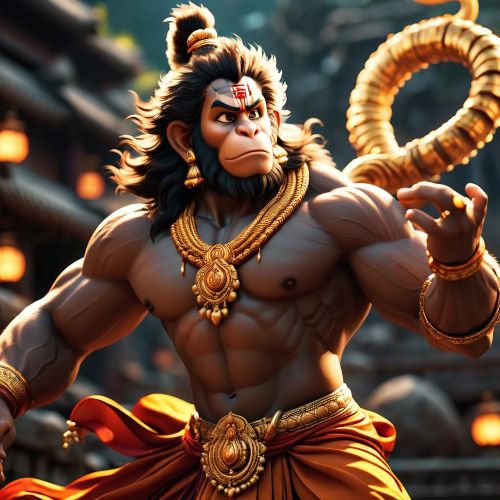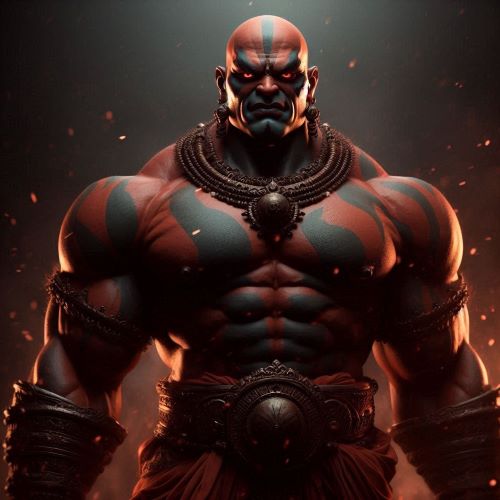Angada : The Vanara Prince
Listen
At a glance
| Description | |
|---|---|
| Origin | Indian Mythology |
| Classification | Hybrids |
| Family Members | Bali (Father), Tara (Mother), Sugreeva (Uncle) |
| Region | India, Cambodia, Indonesia |
| Associated With | Bravery, War, Strength |
Angada
Introduction
Angada, a central figure in the Ramayana, holds a place of honor among the Vanaras, the monkey-like beings who played a crucial role in aiding Lord Rama. As the son of Vali, the formidable Vanara king, and Tara, one of the wisest women in Hindu mythology, Angada inherits both strength and intelligence. His life story is marked by courage, moral integrity, and unwavering loyalty to righteousness. From being a grieving prince who loses his father to becoming a key warrior and diplomat in Rama’s army, Angada’s journey is a compelling narrative of transformation and spiritual resolve. His actions reflect the ideal balance between valor in battle and tact in negotiation, making him an enduring symbol of dharma.
Physical Traits
Angada is known for his striking physical prowess, typical of the Vanaras, who were blessed with immense strength and agility. Although classical texts don’t dwell heavily on his detailed appearance, his feats paint a vivid picture. He possesses the stamina and power to leap great distances, rivaling even Hanuman in certain instances. Perhaps the most memorable instance showcasing his physical might is his challenge in Ravana’s court, where he firmly plants his leg on the ground and dares anyone to move it—none succeed. This act has since become symbolic of unwavering faith and immovable will. He is often portrayed as young, muscular, and dynamic—embodying both the raw energy of youth and the steadiness of a seasoned warrior.
Family
Angada is born into a lineage that blends power with wisdom. His father, Vali, was known across realms for his unmatched strength and command over celestial blessings, while his mother, Tara, was revered for her intellect and calm demeanor. After Vali’s controversial death at the hands of Rama, his uncle Sugriva ascends the throne of Kishkindha, taking Angada under his wing. Despite the emotional conflict over his father’s demise, Angada remains devoted to Rama’s cause, reflecting his deep moral maturity. In time, he forms his own family, marrying the daughter of the Vanara warrior Mainda and fathering a son named Dhruva. Through these bonds, Angada continues the lineage of brave and noble Vanaras.
Other names
The name Angada (Sanskrit: अङ्गदः) carries symbolic and etymological depth. It is commonly associated with an “armlet” or “bracelet,” suggesting a warrior’s ornament and also symbolizing protection and strength. In some interpretations, his name implies someone who grants or bears strong limbs—an allusion to his martial ability and noble heritage. Though primarily referred to as Angada, he is often respectfully called “Valiputra” or “son of Vali,” signifying the importance of his parentage. These references not only highlight his personal identity but also anchor him within the broader context of divine and heroic ancestry.
Powers and Abilities
Angada’s capabilities stretch well beyond brute strength. As a warrior, he displays extraordinary combat skills in the Battle of Lanka, slaying key figures like Narantaka, one of Ravana’s sons, and the demon general Mahaparshva. His participation in critical missions—such as disrupting Indrajit’s yagna to weaken the enemy’s chances of victory—underscores his courage and tactical intelligence. However, Angada’s greatness is not limited to the battlefield. He proves to be an exceptional diplomat during his mission to Ravana’s court, sent as Rama’s final emissary of peace. His words, filled with honesty and unflinching resolve, not only issue a final warning but also reflect the strength of his character. He famously mocks Ravana by fashioning a throne from his tail and sitting above the demon king, making a statement that no sword could match. His unmatched blend of physical might, psychological acumen, and deep loyalty to Rama marks him as a multi-faceted leader. After the war, his merits are recognized, and he is appointed ruler of Kishkindha, bringing stability and honor to his homeland.
Modern Day Influence
Angada’s legacy echoes far beyond the pages of the Ramayana, shaping modern interpretations of loyalty, courage, and diplomatic strategy. In India’s cultural landscape, Angada often features in theatrical productions like Ramlila, where his dialogue with Ravana is portrayed as a powerful example of righteous confrontation. Modern writers and dramatists have reimagined his character in new contexts, such as Thomas Manuel’s stage play Hamlet & Angad, blending classic literature with Indian epics to explore contemporary dilemmas. In Amish Tripathi’s Ram Chandra series, Angada is given a nuanced portrayal, highlighting both his emotional complexity and heroic resolve.
Beyond fiction, his approach to negotiation and conflict resolution is admired in academic and leadership circles. Angada’s conduct in Ravana’s court is sometimes cited in leadership training, emphasizing principles such as moral clarity, dignity under pressure, and the importance of standing firm in truth. His symbolism extends into art and sculpture as well—many temples across India depict scenes involving Angada, immortalizing him in wood, stone, and bronze. Even the name “Angad” continues to hold spiritual significance, particularly within Sikh tradition, where Guru Angad Dev Ji carried forward the teachings of Guru Nanak, further reinforcing the name’s association with strength and spiritual wisdom.
Related Images
Source
Narayan, R. K. (2006). The Ramayana: A Shortened Modern Prose Version of the Indian Epic. Penguin Books.
Subramaniam, N. (2005). Ramayana for Children. Sura Books.
Sah, A. (2019). Valmiki’s Ramayana – The Saga of a Scion Born in Ayodhya. Blue Rose Publishers.
Mittal, J. P. (2006). History Of Ancient India (A New Version): From 7300 BC To 4250 BC. Atlantic Publishers & Dist.
Wisdom Library. (n.d.). Angada, Amgada, Aṅgada: 32 definitions. Retrieved from Wisdom Library
Wikipedia contributors. (n.d.). Angada. Wikipedia. Retrieved August 5, 2025, from https://en.wikipedia.org/wiki/Angada
Temple Yatri. (n.d.). Rama and the Legend of the Vanara General Angada. Retrieved from https://templeyatri.in/rama-and-the-legend-of-the-vanara-general-angada
SculpturePedia. (n.d.). Angada – Prince of Kishkindha. Retrieved from https://sculpturepedia.com/hindu-deity/angada-prince-of-kishkindha
Apna Ayodhya. (2023). The Pivotal Role of Angada in Ramayana. Retrieved from https://apnaayodhya.com/the-pivotal-role-of-angada-in-ramayana
Frequently Asked Questions
What is lorem Ipsum?
I am text block. Click edit button to change this text. Lorem ipsum dolor sit amet, consectetur adipiscing elit. Ut elit tellus, luctus nec ullamcorper mattis, pulvinar dapibus leo.
What is lorem Ipsum?
I am text block. Click edit button to change this text. Lorem ipsum dolor sit amet, consectetur adipiscing elit. Ut elit tellus, luctus nec ullamcorper mattis, pulvinar dapibus leo.
What is lorem Ipsum?
I am text block. Click edit button to change this text. Lorem ipsum dolor sit amet, consectetur adipiscing elit. Ut elit tellus, luctus nec ullamcorper mattis, pulvinar dapibus leo.
What is lorem Ipsum?
I am text block. Click edit button to change this text. Lorem ipsum dolor sit amet, consectetur adipiscing elit. Ut elit tellus, luctus nec ullamcorper mattis, pulvinar dapibus leo.
What is lorem Ipsum?
I am text block. Click edit button to change this text. Lorem ipsum dolor sit amet, consectetur adipiscing elit. Ut elit tellus, luctus nec ullamcorper mattis, pulvinar dapibus leo.


